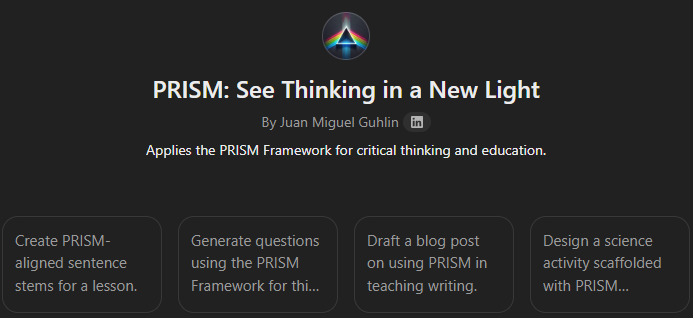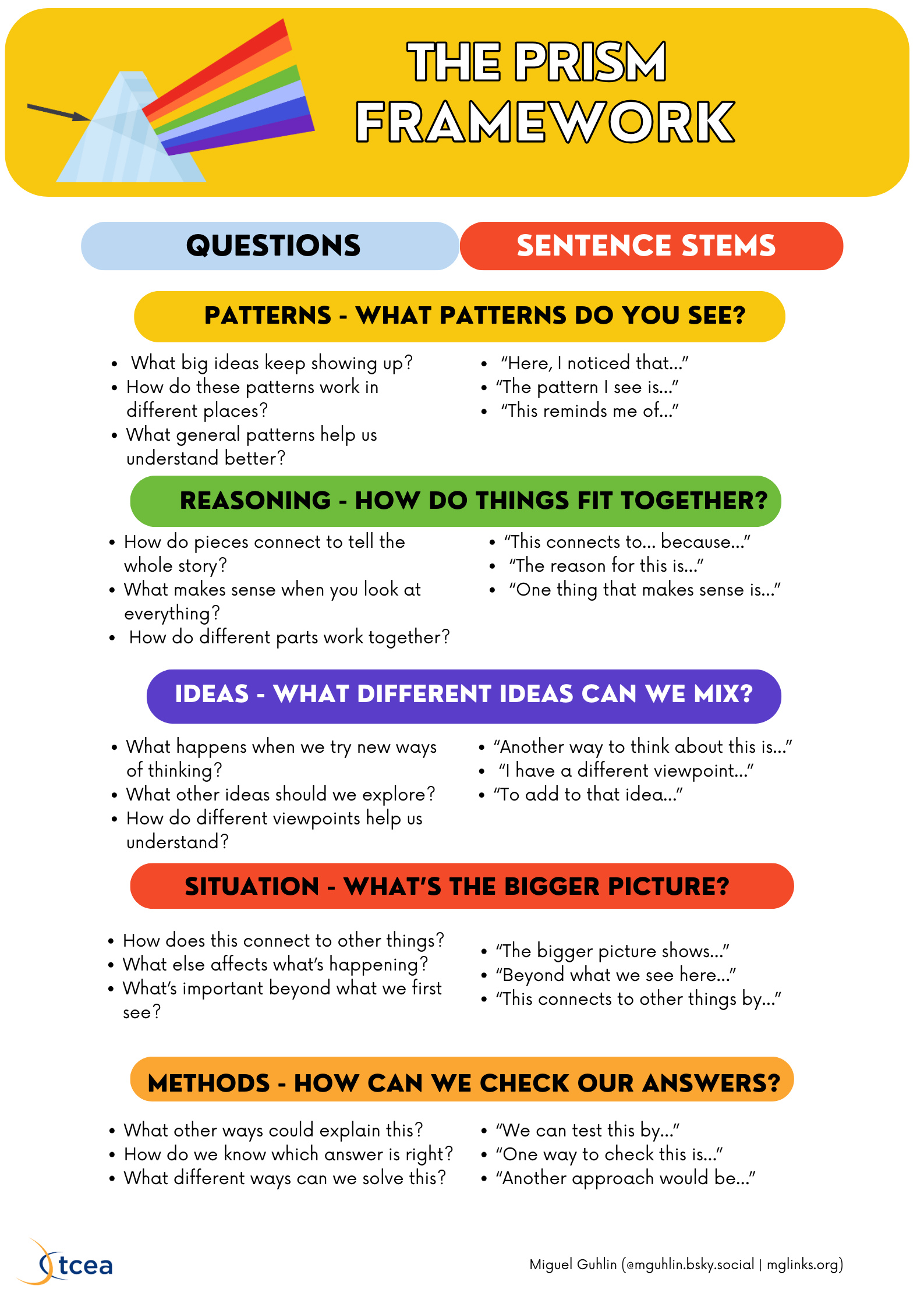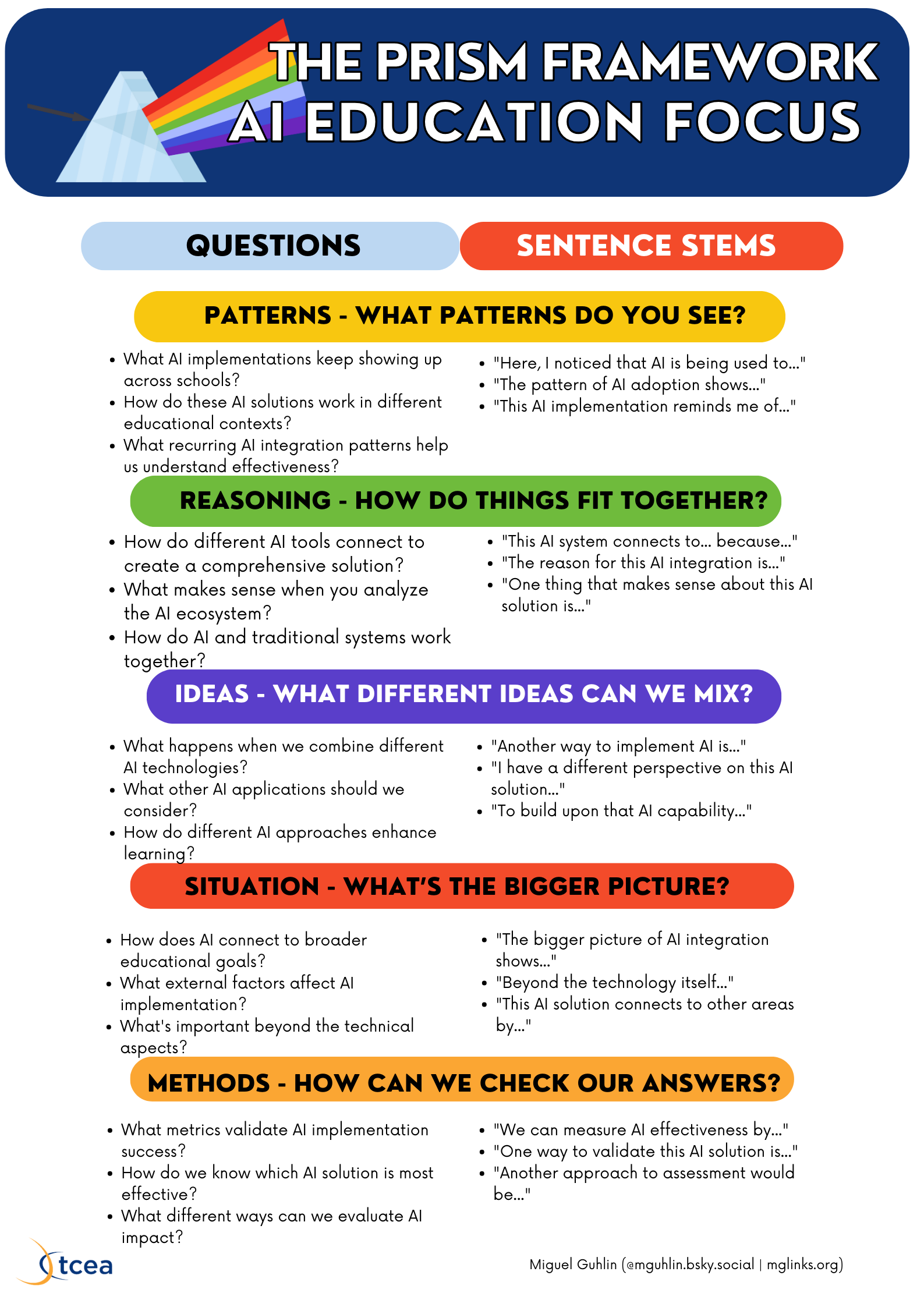PRISM
- PRISM: See Thinking in a New Light
- PRISM: Support Student Science Thinking
- Spectrum of History Learning with the PRISM Framework (Not Yet Published)
- Observe. Make observations, including what I see in Natures, my own experience, thoughts, or reading -** Question.** Generate and ponder questions about recurring patterns in my observations (this is super hard without AI)
- Hypothesize. Come up with ideas or possible explanations about why something is happening or what I’m thinking. It’s a little metacognitive, right?
- Test. This is where you test your explanations (a.k.a. hypotheses) and see if you can make predictions based on your hypothesis. If you can, you may have something that needs even more testing. The idea, to borrow Melanie Trecek King’s wording, is to engage in systematic disconfirmation…to prove our explanations wrong, trying to find one that DOES work and allow us to predict.
- Research. Gather more data to test hypotheses and predictions resulting from those explanations. This can include pulling data from existing research, making our own observations, conducting experiments, and replicating them to to see if others can get the same results.
- Theorize. Come up with a theory for what’s happening that is supported by data and consistent with what other theories say.
MGpt PRISM Framework or Scaffold for Thinking #EduSky
So, if you’ve read my other PRISM framework posts, you probably realized that I relied on AI to help me create stages or steps my brain can climb to move from simple to more complex understanding of a topic. For fun, I thought I’d give this a shot with an MGpt (get it? M GPT? Ok, not that funny) focused on PRISM.

Give the MGpt PRISM Framework a spin
Be sure to read my blog series on the topic over at the TCEA TechNotes blog:
I’m hoping to do a few more focused on various content areas, but TCEA 2025 Convention has dropped like a hunk of concrete and I’m working on my presentations for that event. Don’t forget to sign up this amazing event, and if you see me in the hallway or whatever, drop by and say “Howdy!”
Introducing the PRISM Framework #EduSky #edtech #SOLO
Transform surface learning into deep understanding using patterns, reasoning, ideas, situation, and methods with the PRISM framework!
What if you could use an acronym to spur student thinking to move beyond surface learning to transfer learning? Teachers are student learning watchers. You are eager to see the lightbulb go off in students’ heads. As a teacher, I feel like person waiting for the chick in the egg break out of its shell. I want to help without taking away the productive struggle. What if we could give students the tools they need to move from simple to complex thinking? What if we could make this process a little more obvious for students? That’s the purpose of the PRISM Framework (see the handy infographic below).

Discover the latest in ed tech, teaching strategies, and digital learning from TCEA.
The post PRISM: See Thinking in a New Light appeared first on TCEA TechNotes Blog.
Geoff Petty’s explanation of the SOLO Taxonomy in his book, Evidence-Based Teaching, got me thinking hard. As I read his explanation of the SOLO Taxonomy, I started to wonder, could a model of the SOLO Taxonomy be constructed to aid my own progress from simple to complex levels? I was looking for a way to accelerate my understanding on diverse topics. Of course, I realize now that this is a lot like most processes work, including science, which I realized last week while taking notes on an upcoming online course from TCEA focused on science education in Texas. Dr. Vic, the course developer, highlights this process…here are my notes:
You can easily see how PRISM reflects that. You observe Patterns, you ask questions and Reason how things fit together. You see what Ideas there are out there, reconciling perspectives or not. Then you step back even further to see the big picture, what the Situation is. Then you test what you’ve come up with via various Methods. The main benefit is the sentence stems.
You may be thinking, as I am right now as I type this, “Why is PRISM necessary?” We already have all these processes. Well, one reason may be that the other ones I encountered didn’t stick. Or, it could be what Dr. Judi Harris said so long ago (paraphrase coming up): By reinventing ideas, we make them our own. And that’s not bad since it may help me remember a process, any process, when I most need it.
Lazy Brain
In all honesty, most of us don’t do this, right? I read (Daniel T. Willingham’s Why Don’t Students Like School? Because the Mind Is Not Designed for Thinking ) that we rely on memory rather than thinking because it’s easier and human brains are lazy. PRISM is meant to scaffold thinking, helping us ask questions.
Since using AI can support thinking, it didn’t take me long using AI LLMs like Perplexity AI, ChatGPT as a thought partner and rapid prototyping, then Napkin AI as an artifact developer.
Productive Struggle
Here’s a quick application of PRISM Framework to AI in Education…

All this got me thinking about AI in education, and I think I see a way to blend AI into education that should satisfy AI critics. But that’s another blog entry due out next week. :-)
AI in K-12 Education
Looking for AI Tools for Education with Sample Classroom Uses?
You can find a few listed in this Gamma presentation deck.
Over the last few days, I’ve been playing around with the PRISM Framework, a framework that scaffolds thinking. It is inspired by the SOLO Taxonomy. The PRISM Framework is intended to support thinking as it moves from unistructural to multistructural to relational to extended abstract, as defined in the SOLO Taxonomy. Simply, this means shifting from having no idea to some idea to several ideas (but not knowing how they connect) to seeing how ideas and perspectives connect but unable to make sense of the pattern. It concludes with coming up with a hypothesis of how things fit together and ways to test it.
PRISM takes each of those an generates questions and ideas. I have a few blog entries planned that explore PRISM planned for publication elsewhere, but I’m starting to use PRISM for other things, as way to get thinking going around AI in education, and other topics. Since PRISM is a scaffold for thinking, you can really use it for anything. What’s even more fun, I’ve created a Perplexity Space to assist with applying PRISM to new ideas.
Here’s an AI-generated PRISM relevant to AI in education. It includes updates statistics. Citations have been removed.
A PRISM Analysis: AI in K-12 Education
Patterns
AI adoption in K-12 spread unevenly in 2024. Automated tasks, personalized learning, and cloud management led. Advanced applications lagged. 30% of schools deployed AI, up from 25% in 2023. 80% of teachers use AI-powered platforms weekly.
“I’ve noticed AI creeping into our classrooms, mostly for grading and attendance. It’s like having an invisible teaching assistant.”
Reasoning
Schools adopted AI for efficiency and personalization. It cut teacher workload and boosted engagement. Challenges slowed progress. Infrastructure gaps, lack of training, and privacy concerns held back integration. Only 18% of teachers used AI for teaching in 2023. 37% of districts planned training by 2024.
“AI connects to our need for efficiency, but it’s a double-edged sword. It helps with grading, but we’re still figuring out how to use it safely and effectively.”
Ideas
To improve: Blend AI analytics with teacher interventions. Build comprehensive AI ecosystems. Fix infrastructure. Train teachers. Suburban schools lead in AI training at 23%. Urban and rural schools trail at 17% and 16%. Two-thirds of teachers plan to use more AI soon.
“What if we combined AI-driven analytics with our expertise? We could create personalized learning experiences that truly meet each student where they are.”
Situation
AI reshapes more than classrooms. It impacts district policies, teacher development, and home-school links. It aligns with hybrid learning and future-ready education. 52% believe schools should teach AI use. Only 19% of teachers used AI in their training.
“The bigger picture shows AI isn’t just about classroom tech. It’s changing how we approach education as a whole, from policy to parent communication.”
Methods
To test AI’s impact: Compare outcomes in AI-enhanced and traditional classrooms. Track adoption across demographics. Audit data privacy. Newer teachers use AI more: 21% for those under 10 years, 17% for veterans. High school teachers view AI more negatively than elementary teachers.
“We can validate AI’s effectiveness by comparing student outcomes, but we must also ensure it’s equitable and protects student privacy. It’s a balancing act.”